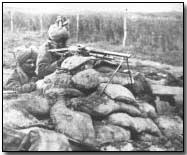Battles - The Battle of Shaiba, 1915
 Following the British
successes at Basra in
November and Qurna in
December 1914, Turkish forces under Colonel Subhi Bey had been driven 13km
further north up the Tigris to Ruta. Despite a failed raid by some
3,000 Anglo-Indian troops on 21 January 1915 Subhi's lines remained static
pending a planned Turkish offensive in April.
Following the British
successes at Basra in
November and Qurna in
December 1914, Turkish forces under Colonel Subhi Bey had been driven 13km
further north up the Tigris to Ruta. Despite a failed raid by some
3,000 Anglo-Indian troops on 21 January 1915 Subhi's lines remained static
pending a planned Turkish offensive in April.
A second Turkish force separately crossed the Tigris into pro-British but neutral Persia. Their target was the British oil pumping station at Ahwaz. To their west, at Nasiriyeh on the River Euphrates, a third force comprising 12,000 men of the Constantinople Fire Brigade (along with 10,000-15,000 Arabs) assembled in readiness for an attack against the British HQ at Basra (the base having been freshly established with its November capture).
The British were themselves reinforcing their presence at Basra via an influx of men from India. However despite possessing numerical supremacy (with a combined force of approximately 30,000 men) the British force suffered, as they did throughout the Mesopotamian campaign, from a want of equipment and supplies (notably of water).
Sir Arthur Barrett, regional Commander-in-Chief, established Basra's main defence 15km south-west of the port, an entrenched position held by around 7,000 professional soldiers.
In due course the Turks initiated their offensive with simultaneous preliminary bombardments of Shaiba and Qurna on 11 April 1915. In the latter case the bombardment of the British 6th (Poona) Division progressed for three days while periodic attempts at piercing the town's defences were unsuccessfully attempted; eventually a counter-attack by the 2nd Dorsets and 24th Punjabis routed the Turks with heavy losses.
 However
the Turks' main effort was launched at Shaiba.
However
the Turks' main effort was launched at Shaiba.
On 13 April, two days after the bombardment of the town started, Turkish troops attempted to outflank the British across the floods that separated Shaiba from Basra, while Turk cavalry prepared for a frontal assault.
However the timely intervention of two British Infantry battalions served to rapidly disperse the Turk cavalry, resulting in a full withdrawal by the latter into woods nearby. Possession of these were in turn secured by the British following an infantry battle throughout 14 April.
Casualties during the woodland battle were heavy: the Turks incurred around 2,400 casualties, and the British around half that number. Some 5,000 troops on each side were involved in the fighting in all.
While the final stages of the Turkish offensive were being planned a new regional British Commander-in-Chief had arrived at Basra to take command of extended operations, Sir John Nixon, superseding General Barrett.
Nixon, encouraged by this latest British success, and acting under Indian government instructions for a so-called 'forward defence', promptly planned further offensive operations - ultimately with disastrous consequences.
Click here to view a map charting operations in Mesopotamia through to 1917.
Photographs courtesy of Photos of the Great War website
Russia mobilised 12 million men during the war; France 8.4 million; Britain 8.9 million; Germany 11 million; Austria-Hungary 7.8 million; Italy 5.6 million; and the USA 4.3 million.
- Did you know?
